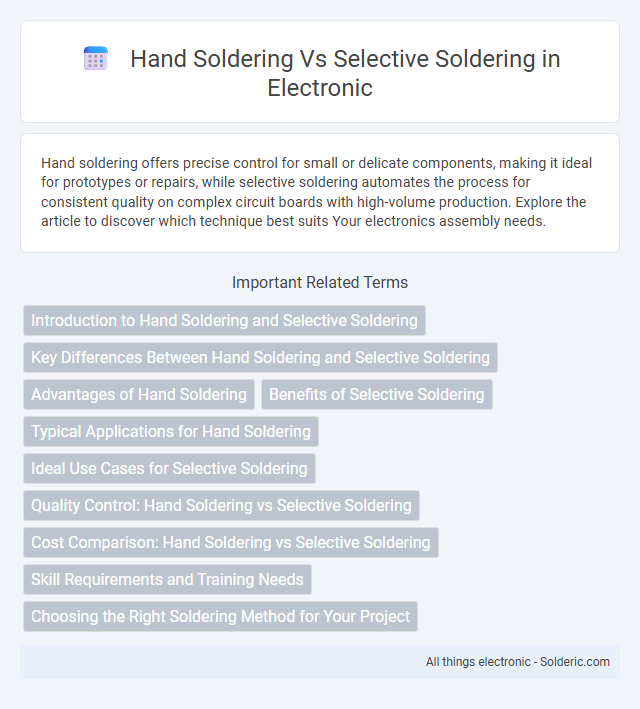Hand soldering offers precise control for small or delicate components, making it ideal for prototypes or repairs, while selective soldering automates the process for consistent quality on complex circuit boards with high-volume production. Explore the article to discover which technique best suits Your electronics assembly needs.
Comparison Table
| Feature | Hand Soldering | Selective Soldering |
|---|---|---|
| Process Type | Manual soldering using soldering iron | Automated soldering targeting specific PCB areas |
| Precision | Moderate, depends on operator skill | High, precise soldering on complex boards |
| Suitable For | Prototyping, repair, low volume production | Medium to high volume, complex PCB assemblies |
| Speed | Slower, manual operation limits speed | Faster, automated process enhances throughput |
| Consistency | Varies with operator, potential for defects | High, consistent quality and reduced defects |
| Cost | Lower initial cost, higher labor cost | Higher initial investment, lower labor cost |
| Training | Requires skilled operator training | Requires programming and maintenance expertise |
| Heat Exposure | Localized, manual heat application | Controlled heat application minimizes PCB damage |
Introduction to Hand Soldering and Selective Soldering
Hand soldering is a manual process where a technician uses a soldering iron to join components, offering precision for small-scale or repair tasks. Selective soldering employs automated machinery to solder specific areas on complex circuit boards, enhancing efficiency and consistency in high-volume production. Your choice depends on factors such as production scale, component complexity, and required accuracy.
Key Differences Between Hand Soldering and Selective Soldering
Hand soldering relies on manual technique to join components using a soldering iron, suitable for small-scale or repair tasks, providing flexibility and precision for intricate work. Selective soldering employs automated machines to precisely apply solder only to specific areas on a printed circuit board, enhancing efficiency and consistency in mass production with reduced risk of thermal damage. Your choice depends on production volume, component density, and the required accuracy of solder joints.
Advantages of Hand Soldering
Hand soldering offers precise control over each solder joint, making it ideal for small-scale production and complex repairs on delicate components. It enables quick adjustments and repairs without the need for extensive setup, reducing downtime in prototyping and low-volume manufacturing. The flexibility of hand soldering accommodates a wide range of component sizes and types, providing a cost-effective solution for customized and intricate soldering tasks.
Benefits of Selective Soldering
Selective soldering offers precise application of solder only to designated areas, reducing the risk of thermal damage to sensitive components compared to hand soldering. This method enhances production efficiency by automating the process, ensuring consistent quality and repeatability, especially for complex or dense PCB assemblies. Your manufacturing yield improves as selective soldering minimizes defects and rework, making it ideal for high-volume and intricate electronic products.
Typical Applications for Hand Soldering
Hand soldering is typically used for prototype development, small-scale production, and repair work due to its precision and flexibility for complex or delicate components. It is ideal for applications requiring manual control over solder joints, such as touch-up tasks, one-off assemblies, and rework on printed circuit boards (PCBs). Industries like aerospace, medical devices, and electronics manufacturing often rely on hand soldering when automated methods cannot accommodate intricate or low-volume jobs.
Ideal Use Cases for Selective Soldering
Selective soldering is ideal for medium to high-volume production runs where precision and repeatability are critical, especially in complex printed circuit boards with mixed through-hole and surface mount components. Your manufacturing process benefits from minimized thermal stress on nearby components and improved solder joint reliability, reducing rework and defects. This technique excels in applications like automotive electronics, aerospace, and medical devices where consistent quality and traceability are essential.
Quality Control: Hand Soldering vs Selective Soldering
Selective soldering offers superior quality control by ensuring precise, repeatable solder joints with consistent heat application, reducing the risk of thermal damage and solder bridging common in hand soldering. Hand soldering depends heavily on the operator's skill, making quality control more variable and prone to human error, which can affect joint reliability and inspection outcomes. Your choice between these methods directly impacts PCB assembly quality, with selective soldering providing enhanced process consistency and better defect management.
Cost Comparison: Hand Soldering vs Selective Soldering
Hand soldering typically incurs lower upfront costs due to minimal equipment requirements, making it suitable for small-scale or prototype assemblies. Selective soldering involves higher initial investment in automated machinery but reduces labor costs and increases production efficiency for large-volume manufacturing. Your choice depends on balancing these cost factors with production scale and precision needs.
Skill Requirements and Training Needs
Hand soldering demands advanced manual dexterity and extensive training to achieve precision in delicate electronic components, often requiring weeks of practice for proficiency. Selective soldering utilizes automated machinery, reducing the operator's skill requirement but necessitating expertise in programming and machine maintenance for optimal performance. Both methods involve specialized training, though hand soldering emphasizes craftsmanship, while selective soldering focuses on technical operation and process control.
Choosing the Right Soldering Method for Your Project
Hand soldering offers precision and flexibility for small-scale or prototype projects, allowing for easy adjustment on complex or sensitive components. Selective soldering provides consistent, high-quality joints ideal for medium to high-volume production, especially when dealing with mixed technology boards or components that require minimal thermal exposure. Choosing the right method depends on factors such as production volume, component type, and desired solder joint reliability.
hand soldering vs selective soldering Infographic

 solderic.com
solderic.com